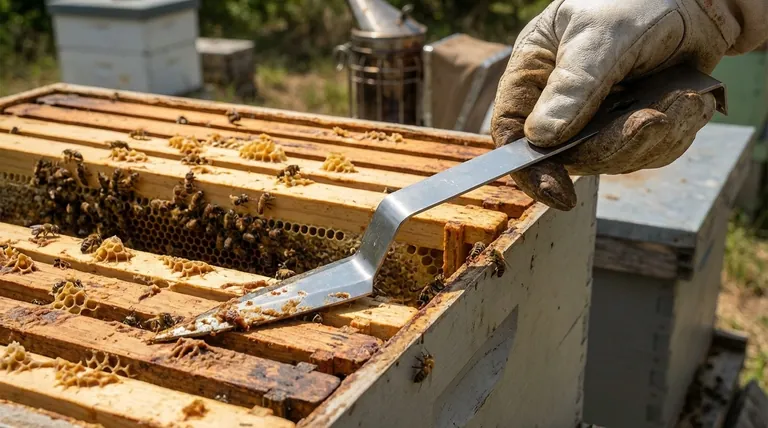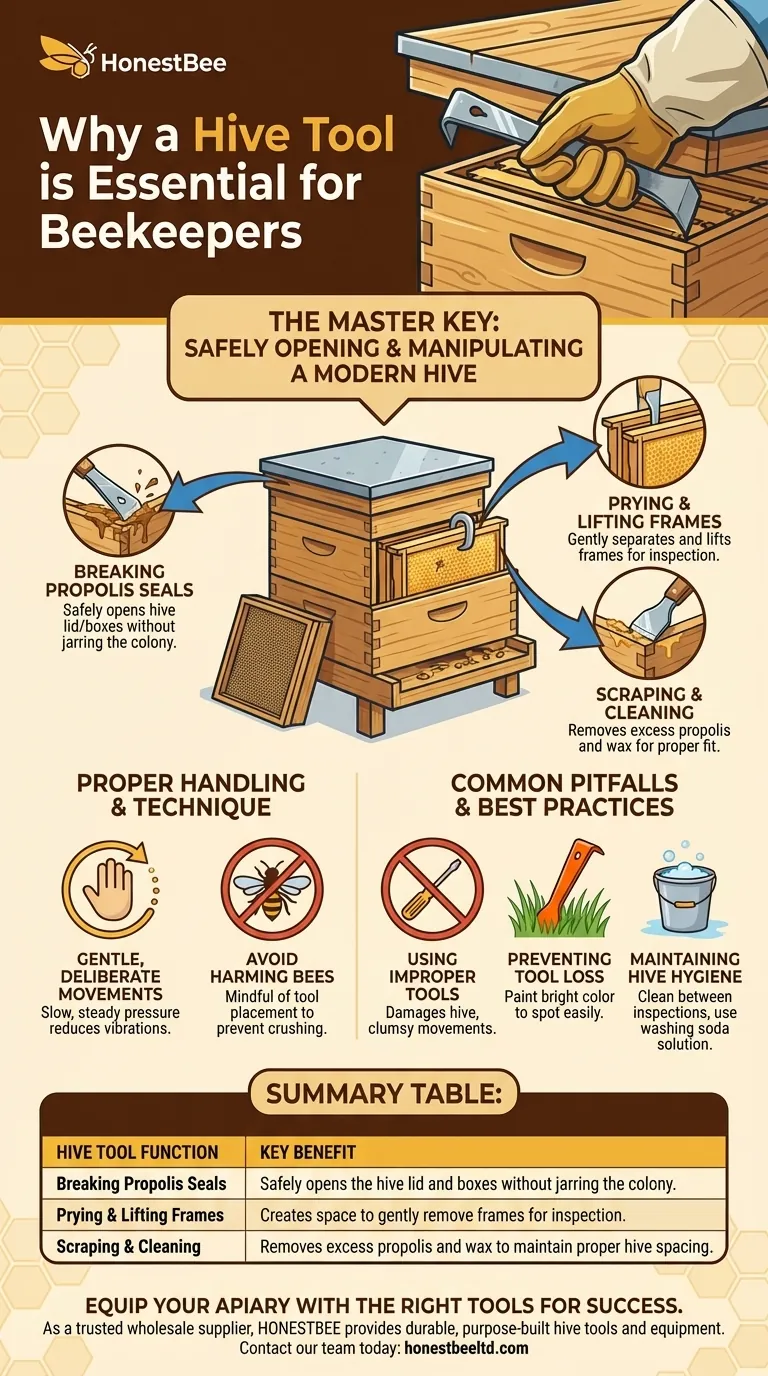A hive tool is essential because it is the only purpose-built instrument for safely opening and manipulating a modern beehive. Bees use a sticky, glue-like substance called propolis to seal every internal component of their hive, making it impossible to inspect without a strong, thin tool to pry parts apart. Attempting an inspection without one is inefficient, stressful for the beekeeper, and potentially harmful to the colony.
The core problem is that bees seal their hive into a single, solid unit with propolis. A hive tool is the master key, providing the leverage needed to break these seals, lift frames, and perform essential maintenance without damaging the hive or harming the bees.

The Primary Functions of a Hive Tool
A beekeeper's hive tool is a multi-purpose device, acting as a mini crowbar, a scraper, and a lever. Its design is deceptively simple, but each feature is critical for interacting with the colony safely and effectively.
Breaking the Propolis Seal
Bees meticulously seal every crack and seam inside their hive with propolis, a resinous mixture they produce. This creates a secure, anti-microbial environment but also glues everything together.
The first and most critical job of the hive tool is to break the seal between the hive lid (or crown board) and the top hive box. The tool’s leverage is necessary to pop this lid off without jarring the entire colony.
Prying and Lifting Frames
Inside the hive, frames are packed tightly together and are also sealed with propolis and wax. It is impossible to simply lift a frame out with your fingers.
The hive tool is used to gently pry frames apart, creating enough space to grip one for inspection. Many tools also feature a "J" or "L" shaped hook specifically designed to hook under the frame's top bar and lift it out of the box.
Scraping and Cleaning
Propolis and excess beeswax (known as burr comb) can build up on frames and hive components, interfering with spacing and inspections.
The flat edge of the hive tool serves as a highly effective scraper. It allows the beekeeper to clean unwanted buildup from the top bars of frames and the edges of the hive boxes, ensuring parts fit together properly.
Proper Handling and Technique
How you use the tool is just as important as having it. The goal is to work calmly and efficiently, minimizing disturbance to the bees.
Use Gentle, Deliberate Movements
Avoid sudden, jarring motions. When prying open the lid or separating frames, apply slow, steady pressure. This reduces vibrations and noise that can alarm the colony and trigger a defensive response.
Avoid Harming the Bees
Always be mindful of where your tool is and where the bees are. Work carefully to avoid crushing bees between frames or between the tool and the hive body. A calm and confident approach leads to a calmer hive.
Common Pitfalls and Best Practices
While essential, the hive tool is also one of the most commonly misplaced items in an apiary. A few simple practices can make your work much smoother.
The Risk of Using Improper Tools
Using a screwdriver or another makeshift tool is a mistake. These items are often too thick, damaging the wooden hive components, or shaped incorrectly, leading to crushed bees and clumsy movements.
Preventing Tool Loss
Hive tools are easily lost in the grass or left behind. To prevent this, paint your hive tool a bright, unnatural color like blue or fluorescent orange. This makes it much easier to spot if you set it down.
Maintaining Hive Hygiene
It is good practice to clean your hive tool between inspections, especially if you are moving between different apiaries. Scraping the tool clean and keeping a bucket with a washing soda solution can help prevent the spread of disease between colonies.
Applying This to Your Beekeeping
Your hive tool is your primary point of interaction with the colony. Selecting and using it correctly is a foundational skill.
- If your primary focus is getting started: Obtain a standard hive tool (like a J-hook style) and practice using slow, gentle leverage to open the hive and separate frames.
- If your primary focus is managing multiple hives: Own several brightly colored hive tools and establish a cleaning protocol to maintain hygiene and prevent cross-contamination between your apiaries.
- If your primary focus is natural beekeeping (e.g., a top-bar hive): A hive tool remains essential for scraping comb from the hive walls and managing propolis, even if you are not lifting standard frames.
This simple piece of steel is the key that unlocks a respectful and effective partnership with your bees.
Summary Table:
| Hive Tool Function | Key Benefit |
|---|---|
| Breaking Propolis Seals | Safely opens the hive lid and boxes without jarring the colony. |
| Prying & Lifting Frames | Creates space to gently remove frames for inspection. |
| Scraping & Cleaning | Removes excess propolis and wax to maintain proper hive spacing. |
Equip your apiary with the right tools for success. As a trusted wholesale supplier to commercial apiaries and distributors, HONESTBEE provides the durable, purpose-built hive tools and equipment you need to manage your colonies efficiently and humanely. Let us help you build a more productive and sustainable operation. Contact our team today to discuss your beekeeping supply needs.
Visual Guide

Related Products
- HONESTBEE Professional Long Handled Hive Tool with Precision Cutting Blade
- HONESTBEE Advanced Ergonomic Stainless Steel Hive Tool for Beekeeping
- Professional Dual-End Stainless Steel Hive Tool for Beekeeping
- Professional Multi-Function Stainless Steel Hive Tool
- HONESTBEE Professional Multi-Functional Hive Tool with Ergonomic Wood Handle
People Also Ask
- Why do hive tools have a hole? Unlock the Secret to Efficient Beekeeping
- What are the features of a regular hive tool? The Essential Multi-Tool for Every Beekeeper
- What are the basic tools for beekeeping? Essential Starter Kit for Safe & Successful Hive Management
- How can a hive tool be used to remove propolis and burr comb? Master Hive Maintenance for a Healthy Colony
- What are some common uses of a hive tool? Essential Multi-Purpose Tool for Every Beekeeper



















